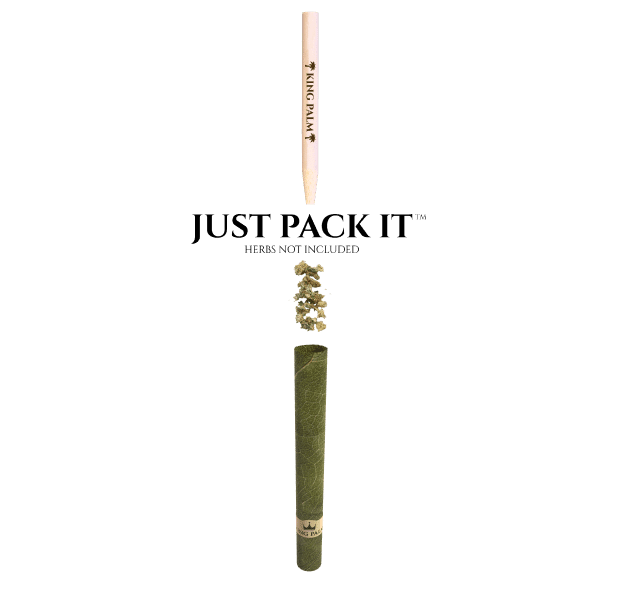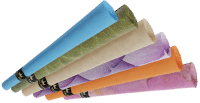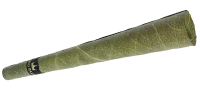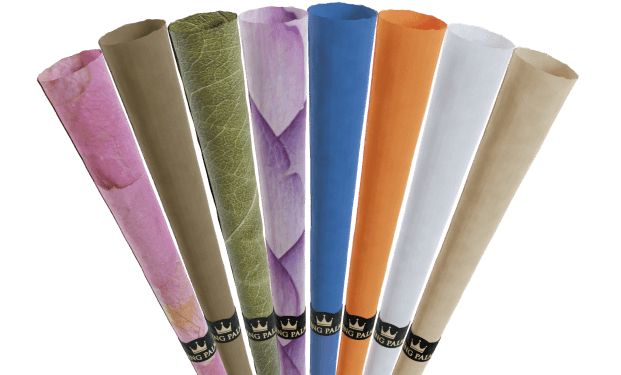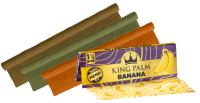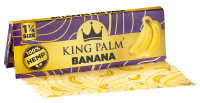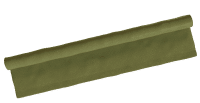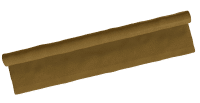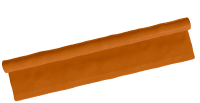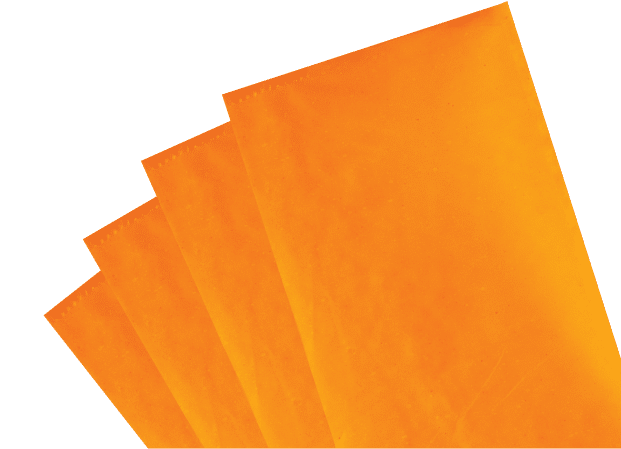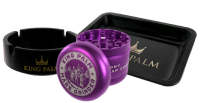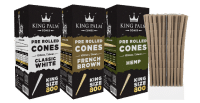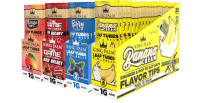Rolling papers are made from hemp, rice, flax, bamboo, or wood pulp. Some of these options use bleach, glues, or flavor additives that contaminate your smoke. For a cleaner session, look for unbleached, additive-free options or skip papers entirely with palm leaf wraps.

If you’ve ever wondered what your papers are actually made of, here’s a quick breakdown of the most common materials and what they mean for your smoke:
Rolling Papers: At-a-Glance
-
Ingredients Matter: Rolling papers are usually made from hemp, rice, flax, bamboo, or wood pulp. Each burns differently and brings its own flavor (or lack thereof).
-
Additives & Bleach: Many white papers are bleached or treated with chemicals to control burn rate or color. These can leave behind residue you don't want to inhale.
-
Glue & Gumming: Some brands use synthetic adhesives that alter taste or combustibility. Look for natural acacia gum, or better yet, no glue at all.
-
Paper Texture & Density: Thicker or overly processed papers can lead to uneven burns, harsh hits, or too much ash.
-
Cleaner Alternatives: Palm leaf wraps offer a natural solution. No bleach, no glue, no pulp. Just a slow, smooth burn that preserves your strain’s flavor.
-
Smarter Flavor Tech: King Palm wraps use terpene-infused tips you can pop or leave intact, giving you control over taste without soaking your paper in chemicals.
The Core Materials You Will Find in Rolling Papers

Rolling papers come in a wide range of materials, each bringing its own qualities to how your session unfolds. The fiber blend affects burn rate, flavor, smoke feel, and even how clean your inhale is. Here is what you need to know about the most common options on the market today.
Hemp
Hemp fibers offer a naturally strong structure and a slow, even burn. Many smokers choose hemp for its plant-based origin, but not all hemp papers are created equal.
Some manufacturers blend hemp with other fibers or introduce additives during processing. Always look for brands that clearly state their material sourcing and production methods.
Flax
Flax-based papers deliver a smooth, flexible feel that many rollers appreciate.
The fibers help create a thin, consistent sheet that burns evenly. Flax blends are popular in premium rolling papers for their handling qualities, though the final burn experience depends on the exact fiber mix used.
Wood Pulp
Wood pulp gives rolling papers extra strength and structure. It is one of the oldest materials used in paper production.
Classic white rolling papers often rely on wood pulp. However, this material typically goes through more intensive processing, and bleaching is common in these varieties. That can impact both flavor and smoke purity.
Rice
Rice papers are known for their ultra-thin profile. They produce minimal ash and can enhance the taste of well-cured flower.
Rice burns faster than hemp or flax and can be more fragile when exposed to humidity. Some rice papers also require careful handling during the roll.
Bamboo
Bamboo papers have gained popularity for their renewable sourcing and light flavor. The burn rate of bamboo can vary by brand. Some use chemical treatments to improve paper performance.
Transparency around processing is key when evaluating bamboo-based options.
Palm Leaf (an Alternative to Paper)
Palm leaf wraps, like those from King Palm, offer a naturally slow-burning option without the need for pulping or chemical additives. The leaf is used in its whole form, shaped into a wrap or pre-roll.
This method preserves the natural taste of the flower and delivers a smooth, cool smoke. Palm leaves also require no glue, gumming, or bleaching, making them a standout alternative for those seeking a cleaner experience.
How Rolling Papers Are Manufactured
Rolling paper production combines traditional techniques with modern equipment. The process transforms raw plant fibers into thin, burnable sheets with consistent performance.
Each stage of production influences the final quality, flavor, and purity of the paper.
Pulping and Fiber Processing
Production begins with raw fibers, hemp, flax, wood pulp, rice, or bamboo. These materials undergo a controlled softening and grinding process.
Heat and mechanical action break the fibers apart while preserving their integrity. The goal is to create a uniform pulp that forms a smooth sheet without introducing contaminants.
Once pulped, the fiber mixture is washed under high pressure. This step removes any residual impurities. The cleaned pulp then enters a large tank, where water is added to create a thin suspension. This watery blend becomes the starting point for sheet formation.
Sheet Formation
The diluted fiber mix is sprayed onto a moving mesh screen called a forming table. As the fibers settle and align, water drains away. Consistent fiber alignment helps create a smooth-burning paper with even thickness.
The sheet then passes through a series of rollers and heated cylinders. These components remove remaining moisture and press the fibers into a finished sheet.
Manufacturers monitor variables like pressure, temperature, and flow throughout this stage to maintain product consistency.
Drying and Watermarking
Once fully dried, the paper rolls onto large reels. Before cutting, some brands add a watermark as a quality signature. Watermarking uses high-pressure rollers to stamp a logo or pattern into the sheet.
It does not affect paper structure but serves as a visible indicator of brand quality standards.
Gumming
A thin line of adhesive is applied next. Acacia gum, sourced from acacia trees, remains a popular natural choice. It creates a secure seal without adding unwanted flavors.
However, some brands use synthetic adhesives that can alter taste and burn quality. Palm leaf wraps eliminate this step entirely. Their structure requires no gum, providing a glue-free alternative.
Cutting and Packaging
Product Featured: King Palm wraps
The final step involves cutting the large paper reels into smaller sizes and formats.
Sheets may be cut and interleaved into booklets or shaped into cones. Packaging varies by brand. Some use sealed pouches or boxes.
Products like King Palm wraps include humidity packs to preserve freshness, a detail often overlooked in traditional rolling papers.
What Else Might Be in Your Rolling Papers?
Many rolling papers appear simple and natural at first glance. The reality is that manufacturing choices can introduce additional substances that affect your smoke. Some ingredients are added intentionally, while others remain as residues from processing.
Bleaching Agents
White rolling papers often undergo a bleaching process to achieve their bright appearance. Chlorine-based or other chemical bleaches can leave trace residues behind.
These substances contribute nothing to flavor or burn quality and can affect the purity of your inhale. Papers made from unbleached plant fibers or alternative materials avoid this step entirely.
Artificial Flavors
Flavored rolling papers frequently rely on artificial coatings.
These chemical flavorings are sprayed onto the paper surface, where they can overpower the natural taste of cannabis and introduce synthetic compounds into the smoke. Palm leaf wraps provide a cleaner option.
King Palm Flavored Hemp Rolling Papers use terpene-infused capsules rather than coating the paper itself. This method gives you full control, you can pop the flavor bead during your session or leave it intact if you prefer an unflavored experience.
Additives and Fillers
Some rolling papers incorporate burn-control agents or fillers. These substances are intended to adjust the paper’s burn rate or appearance but can leave behind unwanted residues.
Transparent brands will disclose whether their papers include such additives. If that information is not easy to find, it is worth questioning why.
Heavy Metals and Pesticides
Concerns about heavy metals in rolling papers have increased in recent years. Independent testing has found elevated levels of metals such as lead and arsenic in some paper brands. In addition, pesticides used during fiber cultivation can remain in the finished product if not properly removed.
Products like King Palm French Brown Rolling Paper 1 1/4 Size Lemon Haze are made with natural palm leaves and undergo strict quality controls. Palm leaves require no pulping or chemical processing, which greatly reduces the risk of residual contaminants.
How Paper Ingredients Affect Your Smoke
The material you roll with has a direct impact on taste, burn quality, and how smooth each inhale feels. Even small differences in paper composition can change how your flower performs once it is lit.
Flavor Preservation
Some rolling papers overpower the natural profile of your bud. Heavy flavor coatings, synthetic glues, or chemical residues can distort the terpene experience. For those who care about taste, the paper should stay out of the way.
King Palm’s palm leaf wraps are made to highlight the strain, not mask it. Their terpene tips give you the option to add flavor with a pop, not with an artificial coating. If you want the full flavor of your flower, leave the tip unpopped.
Burn Quality and Residue
Each fiber type burns differently. Rice papers may burn faster and leave less ash, but can also be brittle. Some hemp blends burn unevenly or leave visible soot.
Paper density and additives also influence how smoothly the paper combusts. Palm leaves offer a slower, cooler burn that many smokers prefer for longer sessions. Options like King Palm French Brown Rolling Paper 1 1/4 Size Lemon Haze are naturally slow-burning without needing burn-control chemicals or fillers.
Inhalation Risks
When you light up, you inhale whatever the paper carries. That includes any glues, bleaches, or synthetic flavorings used during production.
These ingredients do not show up on most labels, so it is up to the smoker to choose brands that are transparent about their materials. Palm leaf wraps reduce this risk. With no bleach, no glue, and no paper pulp, you get a clean experience. King Palm Hemp Rolling Papers use natural gum and avoid the processing shortcuts that can introduce contaminants.
Choosing Smarter Rolling Options
Smokers today have more choices than ever when it comes to rolling materials. But with that choice comes the need to know what is in the product. A better smoke starts with clean materials and clear sourcing.
Look for Materials Transparency
Product Fetaured: King Palm Hemp Rolling Papers
Trustworthy brands clearly state what their papers are made from and how they are processed. If the packaging or website avoids giving details about the fiber source or additives, it is worth asking why.
With King Palm Hemp Rolling Papers, the composition is simple and stated up front: natural hemp with a clean burn and no synthetic coatings. This kind of transparency should be the baseline when choosing any paper or wrap.
Consider Palm Leaf Wraps for a Cleaner Experience
Palm leaf wraps deliver what many smokers are seeking: a slower, smoother burn without the chemicals. No glue, no bleach, no paper taste, these wraps let your flower shine through. King Palm’s line of Flavored Hemp Rolling Papers and palm leaf options offers flexibility.
You can choose a simple hemp paper or a palm wrap with a terpene capsule for enhanced flavor. Both paths deliver a clean inhale backed by thoughtful product design.
What is in Your Rolling Material?
Every smoker deserves to know what is in their rolling materials. With the wide range of papers on the market, it pays to be selective. Additives, synthetic flavors, and bleached fibers can all take away from the quality of your session.
Palm leaf wraps bring a different approach, one built around simplicity and purity. No gum, no bleach, no unnecessary processing. The result is a smooth, slow burn that respects the integrity of your flower.
Ready to experience the difference for yourself?
Explore the full range of King Palm wraps and papers and elevate your next session.

